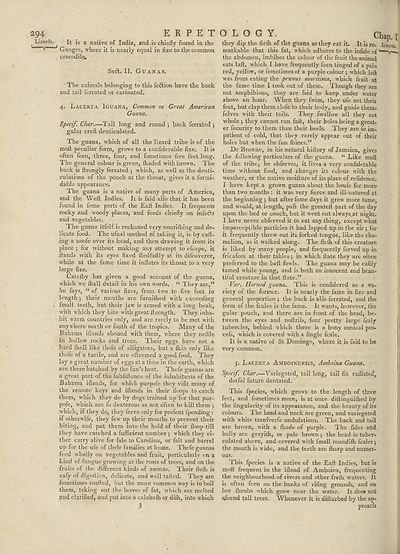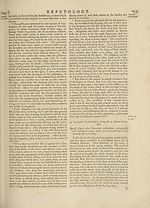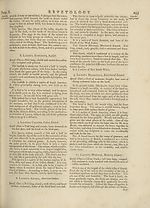Encyclopaedia Britannica, or, a Dictionary of arts, sciences, and miscellaneous literature : enlarged and improved. Illustrated with nearly six hundred engravings > Volume 8, ELE-FOR
(316) Page 294
Download files
Complete book:
Individual page:
Thumbnail gallery: Grid view | List view

4
zards.
O L O G Y. Chap, j
they dip the flefh of the guana as they eat it. It is re- Lizards
markable that this fat, which adheres to the infide of v**
the abdomen, imbibes the colour of the fruit the animal
eats laft, which I have frequently feen tinged of a pale
red, yellow, or fometimes of a purple colour 5 which laft
was from eating the prunus maritima, which fruit at
the fame time I took out of them. Though they are
not amphibious, they are faid to keep under water
above an hour. When they fwim, they ufe not their
feet, but clap them clofe to their body, and guide them-
felves with their tails. They fwallow all they eat
whole j they cannot run fall, their holes being a great¬
er fecurity to them than their heels. They are lb im¬
patient of cold, that they rarely appear out of their
holes but when the fun Ihines.”
Dr Browne, in his natural hillory of Jamaica, gives
the following particulars of the guana. “ Like moft
of the tribe, he obferves, it lives a very confiderable
time without food, and changes its colour with the
weather, or the native moifture of its place of refidence.
I have kept a grown guana about the houfe for more
than two months: it was very fierce and ill-natured at
the beginning ■, but after fome days it grew more tame,
and would, at length, pafs the greateft part of the day
upon the bed or couch, but it went out always at night.
I have never obferved it to eat any thing, except what
imperceptible particles it had lapped up in the air j for
it frequently threw out its forked tongue, like the cha-
melion, as it walked along. The tlefh of this creature
is liked by many people, and frequently ferved up in
fricafees at their tables; in which Hate they are often
preferred to the bell fowls. The guana may be eafily
tamed while young, and is both an innocent and beau¬
tiful creature in that ftate.”
Var. Honied guana. This is confidered as a va¬
riety of the former. It is nearly the lame in fize and
general proportion } the back is alfo ferrated, and the
form of the fcales is the fame. It wants, however, the
gular pouch, and there are in front of the head, be¬
tween the eyes and noftrils, four pretty large fcaly
tubercles, behind which there is a bony conical pro-
cefs, which is covered with a fingle fcale.
It is a native of St Domingo, where it is faid to be
very common.
E R P E T
It is a native of India, and is chiefly found in the
Ganges, where it is nearly equal in fize to the common
crocodile^
Se&. II. Guanas.
The animals belonging to this feefion have the back
and tail ferrated or carinated.
4. Lacerta Iguana, Common or Great American
Guana.
Specif. Char.—Tail long and round ; back ferrated j
gular creft denticulated.
The guana, which of all the lizard tribe is of the
moft peculiar form, grows to a confiderable fize. It is
often feen, three, four, and fometimes five feet long.
The general colour is green, (haded with brown. The
back is ftrongly ferrated ; which, as well as the denti-
culations of the pouch at the throat, gives it a formi¬
dable appearance.
The guana is a native of many parts of America,
and the Weft Indies. It is faid alfo that it has been
found in fome parts of the Eaft Indies. It frequents
rocky and woody places, and feeds chiefly on infedls
and vegetables.
The guana itfelf is reckoned very nourifhing and de¬
licate food. The ufual method of taking it, is by call¬
ing a noofe over its head, and then drawing it from its
place j for without making any attempt to efcape, it
(lands with its eyes fixed ftedfaftly at its difeoverer,
while at the fame time it inflates its throat to a very
large fize.
Catelby has given a good account of the guana,
which wre (hall detail in his own words. “ They are,”
he fays, “ of various fizes, from two to five feet in
length} their mouths are furniihed with exceeding
fmall teeth, but their jaw is armed with a long beak,
with which they bite with great ftrength. They inha¬
bit w arm countries only, and are rarely to be met with
anywhere north or fouth of the tropics. Many of the
Bahama iflands abound with them, where they neftle
in hollow rocks and trees. Their eggs have not a
hard (hell like thofe of alligators, but a (kin only like
thofe of a turtle, and are efteemed a good food. They
lay a great number of eggs at a time in the earth, which
are there hatched by the fun’s heat. Thefe guanas are
a great part of the fubfiftence of the inhabitants of the
Bahama iflands, for which purpofe they vifit many of
the remote keys and iflands in their (loops to catch
them, which they do by dogs trained up for that pur¬
pofe, which are fo dexterous as not o'ften to kill them 5
which, if they do, they ferve only for prefent (pending :
if otherwife, they few up their mouths to prevent their
biting, and put them into the hold of their (loop till
they have catched a fufficient number j which they ei¬
ther carry alive for fale to Carolina, or fait and barrel
up for the ufe of their families at home. Thefe guanas
feed wholly on vegetables and fruit, particularly on a
kind of fungus growing at the roots of trees, and on the
fruits of the different kinds of anonas. Their flefti is
eafy of digeftion, delicate, and well tailed. They are
fometimes roafted, but the more common way is to boil
them, taking out the leaves of fat, which are melted
and clarified, and put into a calabaftr or di(h, into which
3
5. Lacerta Amboinensis, Amhoina Guana.
Specif. Char.—Variegated, tail long, tail fin radiated,
dorfal future dentated.
This fpecies, which grows to the length of three
feet, and fometimes more, is at once diftinguiftied by
the Angularity of its appearance, and the beauty of its
colours. The head and neck are green, and variegated
with white tranfverfe undulations. The back and tail
are brown, with a (hade of purple. The (ides aftd
belly are grayilh, or pale brown *, the head is tuber-
culated above, and covered with fmall roundiftt fcales;
the mouth is w ide, and the teeth are (harp and numer¬
ous.
This fpecies is a native of the Eaft Indies, but is
moft frequent in the ifland of Amboina, frequenting
the neighbourhood of rivers and other frefh waters. It
is often feen on the banks of riling grounds, and on
low (hrubs which grow near the water. It does not
Rfcend tall trees. Whenever it is difturbed by the ap-
zards.
O L O G Y. Chap, j
they dip the flefh of the guana as they eat it. It is re- Lizards
markable that this fat, which adheres to the infide of v**
the abdomen, imbibes the colour of the fruit the animal
eats laft, which I have frequently feen tinged of a pale
red, yellow, or fometimes of a purple colour 5 which laft
was from eating the prunus maritima, which fruit at
the fame time I took out of them. Though they are
not amphibious, they are faid to keep under water
above an hour. When they fwim, they ufe not their
feet, but clap them clofe to their body, and guide them-
felves with their tails. They fwallow all they eat
whole j they cannot run fall, their holes being a great¬
er fecurity to them than their heels. They are lb im¬
patient of cold, that they rarely appear out of their
holes but when the fun Ihines.”
Dr Browne, in his natural hillory of Jamaica, gives
the following particulars of the guana. “ Like moft
of the tribe, he obferves, it lives a very confiderable
time without food, and changes its colour with the
weather, or the native moifture of its place of refidence.
I have kept a grown guana about the houfe for more
than two months: it was very fierce and ill-natured at
the beginning ■, but after fome days it grew more tame,
and would, at length, pafs the greateft part of the day
upon the bed or couch, but it went out always at night.
I have never obferved it to eat any thing, except what
imperceptible particles it had lapped up in the air j for
it frequently threw out its forked tongue, like the cha-
melion, as it walked along. The tlefh of this creature
is liked by many people, and frequently ferved up in
fricafees at their tables; in which Hate they are often
preferred to the bell fowls. The guana may be eafily
tamed while young, and is both an innocent and beau¬
tiful creature in that ftate.”
Var. Honied guana. This is confidered as a va¬
riety of the former. It is nearly the lame in fize and
general proportion } the back is alfo ferrated, and the
form of the fcales is the fame. It wants, however, the
gular pouch, and there are in front of the head, be¬
tween the eyes and noftrils, four pretty large fcaly
tubercles, behind which there is a bony conical pro-
cefs, which is covered with a fingle fcale.
It is a native of St Domingo, where it is faid to be
very common.
E R P E T
It is a native of India, and is chiefly found in the
Ganges, where it is nearly equal in fize to the common
crocodile^
Se&. II. Guanas.
The animals belonging to this feefion have the back
and tail ferrated or carinated.
4. Lacerta Iguana, Common or Great American
Guana.
Specif. Char.—Tail long and round ; back ferrated j
gular creft denticulated.
The guana, which of all the lizard tribe is of the
moft peculiar form, grows to a confiderable fize. It is
often feen, three, four, and fometimes five feet long.
The general colour is green, (haded with brown. The
back is ftrongly ferrated ; which, as well as the denti-
culations of the pouch at the throat, gives it a formi¬
dable appearance.
The guana is a native of many parts of America,
and the Weft Indies. It is faid alfo that it has been
found in fome parts of the Eaft Indies. It frequents
rocky and woody places, and feeds chiefly on infedls
and vegetables.
The guana itfelf is reckoned very nourifhing and de¬
licate food. The ufual method of taking it, is by call¬
ing a noofe over its head, and then drawing it from its
place j for without making any attempt to efcape, it
(lands with its eyes fixed ftedfaftly at its difeoverer,
while at the fame time it inflates its throat to a very
large fize.
Catelby has given a good account of the guana,
which wre (hall detail in his own words. “ They are,”
he fays, “ of various fizes, from two to five feet in
length} their mouths are furniihed with exceeding
fmall teeth, but their jaw is armed with a long beak,
with which they bite with great ftrength. They inha¬
bit w arm countries only, and are rarely to be met with
anywhere north or fouth of the tropics. Many of the
Bahama iflands abound with them, where they neftle
in hollow rocks and trees. Their eggs have not a
hard (hell like thofe of alligators, but a (kin only like
thofe of a turtle, and are efteemed a good food. They
lay a great number of eggs at a time in the earth, which
are there hatched by the fun’s heat. Thefe guanas are
a great part of the fubfiftence of the inhabitants of the
Bahama iflands, for which purpofe they vifit many of
the remote keys and iflands in their (loops to catch
them, which they do by dogs trained up for that pur¬
pofe, which are fo dexterous as not o'ften to kill them 5
which, if they do, they ferve only for prefent (pending :
if otherwife, they few up their mouths to prevent their
biting, and put them into the hold of their (loop till
they have catched a fufficient number j which they ei¬
ther carry alive for fale to Carolina, or fait and barrel
up for the ufe of their families at home. Thefe guanas
feed wholly on vegetables and fruit, particularly on a
kind of fungus growing at the roots of trees, and on the
fruits of the different kinds of anonas. Their flefti is
eafy of digeftion, delicate, and well tailed. They are
fometimes roafted, but the more common way is to boil
them, taking out the leaves of fat, which are melted
and clarified, and put into a calabaftr or di(h, into which
3
5. Lacerta Amboinensis, Amhoina Guana.
Specif. Char.—Variegated, tail long, tail fin radiated,
dorfal future dentated.
This fpecies, which grows to the length of three
feet, and fometimes more, is at once diftinguiftied by
the Angularity of its appearance, and the beauty of its
colours. The head and neck are green, and variegated
with white tranfverfe undulations. The back and tail
are brown, with a (hade of purple. The (ides aftd
belly are grayilh, or pale brown *, the head is tuber-
culated above, and covered with fmall roundiftt fcales;
the mouth is w ide, and the teeth are (harp and numer¬
ous.
This fpecies is a native of the Eaft Indies, but is
moft frequent in the ifland of Amboina, frequenting
the neighbourhood of rivers and other frefh waters. It
is often feen on the banks of riling grounds, and on
low (hrubs which grow near the water. It does not
Rfcend tall trees. Whenever it is difturbed by the ap-
Set display mode to:
![]() Universal Viewer |
Universal Viewer | ![]() Mirador |
Large image | Transcription
Mirador |
Large image | Transcription
Images and transcriptions on this page, including medium image downloads, may be used under the Creative Commons Attribution 4.0 International Licence unless otherwise stated. ![]()
| Permanent URL | https://digital.nls.uk/192267527 |
|---|
| Attribution and copyright: |
|
|---|
| Description | Ten editions of 'Encyclopaedia Britannica', issued from 1768-1903, in 231 volumes. Originally issued in 100 weekly parts (3 volumes) between 1768 and 1771 by publishers: Colin Macfarquhar and Andrew Bell (Edinburgh); editor: William Smellie: engraver: Andrew Bell. Expanded editions in the 19th century featured more volumes and contributions from leading experts in their fields. Managed and published in Edinburgh up to the 9th edition (25 volumes, from 1875-1889); the 10th edition (1902-1903) re-issued the 9th edition, with 11 supplementary volumes. |
|---|---|
| Additional NLS resources: |
|

